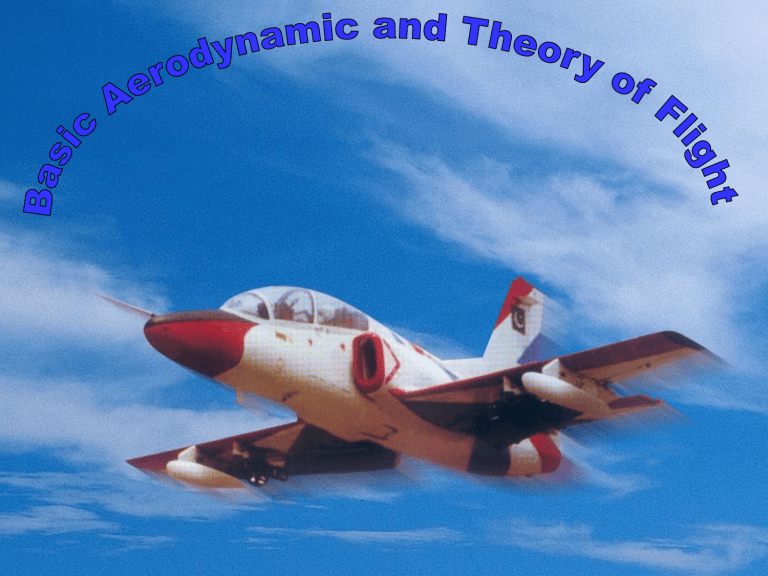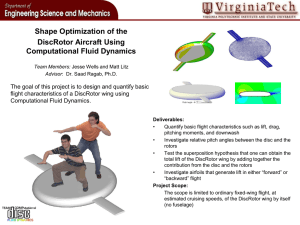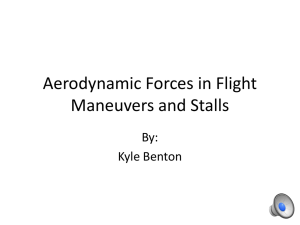
Outline of Presentation Introduction The Atmosphere Newton’s Laws of Motion Bernoulli’s Principle Airfoil Parts of an Airplane The Four Forces of Flight Three Axes of Movement Stability Control INTRODUCTION It is unnecessary that a mechanic be totally versed on Aerodynamics and Theory of Flight. However he must understand the relationships between the atmosphere, the aircraft and the forces acting on it in flight, in order to make intelligent decisions affecting the flight safety of both airplanes and helicopters. Aerodynamics Aerodynamics is the study of objects in motion through the air and the forces that produce or change such motion. The Atmosphere Air is a mixture of gases composed principally of nitrogen and oxygen. An aircraft operates in the air, therefore, the properties of air that affect aircraft control and performance must be understood. Pressure – Atmospheric pressure varies with altitude. The higher an object rises above sea level, the lower the pressure. Density – It varies directly with the pressure and inversely with the temperature. With the same horse power, an aircraft can fly faster at high altitude because of less resistance of air at there. Humidity – Humidity is the amount of water vapor in the air. It varies directly with temperature. Newton's First Law of Motion According to Newton's first law of motion (inertia), an object at rest will remain at rest, or an object in motion will continue in motion at the same speed and in the same direction, until an outside force acts on it. For an aircraft to taxi or fly, a force must be applied to it. It would remain at rest without an outside force. Once the aircraft is moving, another force must act on it to bring it to a stop. It would continue in motion without an outside force. This willingness of an object to remain at rest or to continue in motion is referred to as inertia. Newton's Second Law of Motion The second law of motion (force) states that if a object moving with uniform speed is acted upon by an external force, the change of motion (acceleration) will be directly proportional to the amount of force and inversely proportional to the mass of the object being moved. The motion will take place in the direction in which the force acts. Simply stated, this means that an object being pushed by 10 pounds of force will travel faster than it would if it were pushed by 5 pounds of force. A heavier object will accelerate more slowly than a lighter object when an equal force is applied. F=m×a Newton's Third Law of Motion The third law of motion (action and reaction) states that for every action (force) there is an equal and opposite reaction (force). This law can be demonstrated with a balloon. If you inflate a balloon with air and release it without securing the neck, as the air is expelled the balloon moves in the opposite direction of the air rushing out of it. Figure shows this law of motion. Balloon Reaction Air Action BERNOULLI'S PRINCIPLE Bernoulli's principle states that when a fluid flowing through a tube reaches a constriction or narrowing of the tube, the speed of the fluid passing through the constriction is increased and its pressure is decreased. Pressure Drop in Venturi Tube Airfoil An airfoil is the shape of a wing or blade (of a propeller, rotor or turbine) as seen in cross-section. An aircraft's wings, horizontal, and vertical stabilizers are built with airfoil-shaped cross sections, as are helicopter rotor blades. - The mean camber line is a line drawn midway between the upper and lower surfaces. - The chord line is a straight line connecting the leading and trailing edges of the airfoil, at the ends of the mean camber line. Chord line Mean camber line Airfoil as a Venturi Tube kinetic energy (velocity) velocity increases potential energy (pressure) pressure decreases Lift force appear Parts of an Airplane Cockpit Empennage Fuselage Stabilizers Wing Rudder Flap Elevator Aileron Engine Parts of An Airplane The Four Forces of Flight The forces acting on an airplane in flight are lift, weight, thrust, and drag. These forces are in equilibrium during straight-andlevel, unaccelerated flight. LIFT DRAG THRUST WEIGHT Lift Lift is the force created by the interaction between the wings and the airflow. It always act upwards. It is considered to be the 'most important force' as without it, an aircraft cannot ascend from ground and maintain altitude. Lift is an aerodynamic force Lift must exceed weight for flight Generated by motion of aircraft through air Created by the effects of airflow past wing Aircraft lift acts through a single point called the center of pressure. Newton’s Third Law and Lift Newton’s Second Law and Lift Lift: Wing Section Lift Equation: L=CL × ½ ρ × A × V2 Angle of Attack • The angle of attack is the angle between the chord line and the average relative wind. • Greater angle of attack creates more lift (up to a point). Angle of Attack and Lift Force High velocity Low pressure Low velocity High pressure Angle of Incidence • The angle of incidence is the angle between the chord line and the longitudinal axis of aircraft. • It is the angle of wing setting. • When the leading edge of the wing is higher than the trailing edge, the angle of incidence is said to be positive. It is negative when the leading edge is lower than the trailing edge of the wing. Angle of incidence Horizontal Component of Lift Lift and Induced Drag • Lift acts through the center of pressure, and perpendicular to the relative wind. • This creates induced drag. induced drag effective lift total lift Shape of the Airfoil • The shape of the airfoil determines the amount of turbulences or skin friction that it will produce. The shape of a wing consequently affects the efficiency of the wing. A wing may have various airfoil section from root to tip, with taper, twist, sweep back and sweep forward. Wing Shapes Weight This force acts on an aircraft due to the interaction between the aircraft's body weight and Earth's gravity. Weight is a downward force. Weight is not constant Varies with passengers, cargo, fuel load Decreases as fuel is consumed or payload off-loaded Direction is constant toward earth’s center Acts through a single point called the center of gravity (the CG) Thrust This force is created by an aircraft's engine and is required for forward motion. Forward-acting force opposes drag Direction of thrust depends on design Propulsion systems produce thrust Equal to drag in straight, constant speed flight Drag This force acts in reverse direction to that of 'Thrust' and hinders forward motion. Drag is considered as a negative force and all engineers try their best to reduce drag. An aerodynamic force. Resists forward motion. Increases with the square of speed. Two broad drag classifications. – Parasite drag: drag created by airplane shape. A result of air viscosity. – Induced drag: by-product of lift generation. Caused by the wingtip vortices. Drag Equation: D=CD × ½ ρ × A × V2 Example of Drag Formation Skin Friction Drag Three Axes of Movement Axis of Yaw (Vertical Axis) Axis of Roll (Longitudinal Axis) Axis of Pitch (Lateral Axis) Pitch Around the Lateral Axis Roll Around Longitudinal Axis Yaw Around the vertical Axis Stability An aircraft must have sufficient stability to maintain a uniform flight path and recover from the various upsetting forces also to achieve the best performance. There are two types of stability Static Stability - The initial movement of an object after being disturbed. – Positive Static Stability – returns to position before displacement. – Neutral Static Stability – tendency to remain in displaced position. – Negative Static Stability – tends to continue away from displaced position in same direction. Dynamic Stability - The behavior of the object over time. – Positive Dynamic Stability – the oscillations or phugoids dampen themselves out. – Neutral Dynamic Stability – the oscillations or phugoids carry on with out increasing in severity. – Negative Dynamic Stability – the oscillations or phugoids increase in severity and diverge. Static Stability Positive-Neutral-Negative Dynamic Stability Positive Dynamic Stability Natural Dynamic Stability Negative Dynamic Stability Stability recover by a dihedral wing Smaller wing area Larger wing area More lift Less lift Stability recover by a sweep back wing Stability recover by keel effect CONTROL To achieve the best performance, the aircraft must have the proper response to the movement of the controls. Control is the action taken to make the aircraft follow any desired flight path. Different Control surfaces are used to control the aircraft about each of the three axes. Flight Control Surfaces – Hinged or moveable airfoils designed to change the attitude of the aircraft during flight. 3. Auxiliary group 1. Primary group - wing flaps - ailerons - spoilers - elevators - speed brakes - rudder - slats 2. Secondary group - leading edge flaps - trim tab, spring tab - slots - servo tab, balance tab Flight Control Surfaces Spoiler Spoiler Flap Flap wing flaps leading edge slots spoilers leading edge slats speed brakes Control around the Longitudinal Axis ROLLING Ailerons – The ailerons form a part of the wing and are located in the trailing edge of the wing towards the tips. The control stick is connected by means of wires or hydraulics to the wings’ ailerons. By turning the stick, the pilot can change the positions of the ailerons. Control around the Vertical Axis YAWING Rudder – The rudder is a moveable control surface attached to the trailing edge of the vertical stabilizer. The foot pedals are connected by means of wires or hydraulics to the rudder of the tail section. The rudder can also be used in controlling a bank or turn in flight. Moving rudder to the right forces tail to the left, nose to the right Moving rudder to the left forces tail to the right, nose to the left. Control around the Lateral Axis PITCHING Elevators – Elevators are the movable control surfaces hinged to the trailing edge of the horizontal stabilizer. The control stick is connected by means of wires or hydraulics to the tail section’s elevators. - Stabilator - Ruddervator




